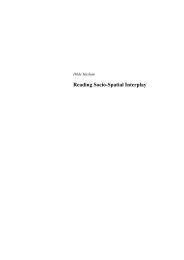CON ⢠TEXT - Arkitektur- og designhøgskolen i Oslo - AHO
CON ⢠TEXT - Arkitektur- og designhøgskolen i Oslo - AHO
CON ⢠TEXT - Arkitektur- og designhøgskolen i Oslo - AHO
- No tags were found...
You also want an ePaper? Increase the reach of your titles
YUMPU automatically turns print PDFs into web optimized ePapers that Google loves.
S T R A T E G Ytheir beliefs, desires, theories, values, and so on” (Bruner 1991:7). Thesenarratives will highlight the particular situations that mark a transition fromthe order that has previously been characteristic of the situation. This doesnot imply order in the sense that there was complete and utter peace in asetting, but order as in the normal, the known. In the case of DKS, this is notone order, but two — the artists’ art practice, and the A&C teachers’educational practice. To get at the value sets that are engaged, and theparticular situation, the normal, the known is of equal importance as a factor.“Particularity achieves its emblematic status by its embeddedness in a storythat is in some sense generic” (Bruner 1991:7). Particular events — transitorysituations — will only achieve the status as transitory because they representa shift from the known to something new and unknown. The story ischaracterised by the particular events — and events get their importance as abreak in the story as a whole. Wenger’s community of practice presents valuesets as constructed through negotiation with different levels (Wenger 1998).This resounds in narrative theory, where all levels are seen as shaping thetelling of a narrative:“Each field of practice (including the practice of research) has,at any point in time, a series of stories in circulation. They areoffered to newcomers as the means of introduction to acommunity, but they are also repeated in the presence of thevery actors who participated in this event, thus consolidating acommunity feeling by reifying its history” (Czarniawska2004:36).As previously mentioned, the narratives existing in public space concerningthe DKS pr<strong>og</strong>ram has increased drastically during the period 2004 — 2008.Media has distributed views and negotiation of the conflict in terms of boththe ‘school world’ and the ‘art world’. Media communicated stories aboutDKS collaborations and projects can be found in the national newspapers.These narratives are a common ground for public opinion in regards to thepr<strong>og</strong>ram, and will be decisive in the setting up of jurisdictional boundaries(Abbott 1988; 1995). Narratives can be seen as stories of lived professionalpractice (Bruner 1991; 2004; Czarniawska 2004; Lieblich et al. 1998). \Themedia plays a large part of our lives today, not only as individual articlesreleased as single tales, but as a complete ongoing narrative, where thearticles are all part of a larger narrative and constitute arguments in ajustification of professional choices.When the actors from the ‘art world’ and the ‘school world’ meet the DKSpractice in school projects for the first time, they are not unfamiliar with it.They have extensive knowledge through the introduction narratives for the31
















